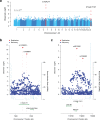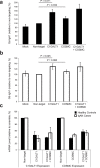GWAS for serum galactose-deficient IgA1 implicates critical genes of the O-glycosylation pathway
- PMID: 28187132
- PMCID: PMC5328405
- DOI: 10.1371/journal.pgen.1006609
GWAS for serum galactose-deficient IgA1 implicates critical genes of the O-glycosylation pathway
Abstract
Aberrant O-glycosylation of serum immunoglobulin A1 (IgA1) represents a heritable pathogenic defect in IgA nephropathy, the most common form of glomerulonephritis worldwide, but specific genetic factors involved in its determination are not known. We performed a quantitative GWAS for serum levels of galactose-deficient IgA1 (Gd-IgA1) in 2,633 subjects of European and East Asian ancestry and discovered two genome-wide significant loci, in C1GALT1 (rs13226913, P = 3.2 x 10-11) and C1GALT1C1 (rs5910940, P = 2.7 x 10-8). These genes encode molecular partners essential for enzymatic O-glycosylation of IgA1. We demonstrated that these two loci explain approximately 7% of variability in circulating Gd-IgA1 in Europeans, but only 2% in East Asians. Notably, the Gd-IgA1-increasing allele of rs13226913 is common in Europeans, but rare in East Asians. Moreover, rs13226913 represents a strong cis-eQTL for C1GALT1 that encodes the key enzyme responsible for the transfer of galactose to O-linked glycans on IgA1. By in vitro siRNA knock-down studies, we confirmed that mRNA levels of both C1GALT1 and C1GALT1C1 determine the rate of secretion of Gd-IgA1 in IgA1-producing cells. Our findings provide novel insights into the genetic regulation of O-glycosylation and are relevant not only to IgA nephropathy, but also to other complex traits associated with O-glycosylation defects, including inflammatory bowel disease, hematologic disease, and cancer.
Conflict of interest statement
The authors have declared that no competing interests exist.
Figures




References
MeSH terms
Substances
Grants and funding
LinkOut - more resources
Full Text Sources
Other Literature Sources
Miscellaneous

